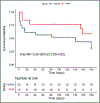Transcatheter Palliation With Pulmonary Artery Flow Restrictors in Neonates With Congenital Heart Disease: Feasibility, Outcomes, and Comparison With a Historical Hybrid Stage 1 Cohort
- PMID: 38113289
- PMCID: PMC11791650
- DOI: 10.1161/CIRCINTERVENTIONS.123.013383
Transcatheter Palliation With Pulmonary Artery Flow Restrictors in Neonates With Congenital Heart Disease: Feasibility, Outcomes, and Comparison With a Historical Hybrid Stage 1 Cohort
Abstract
Background: Neonates with complex congenital heart disease and pulmonary overcirculation have been historically treated surgically. However, subcohorts may benefit from less invasive procedures. Data on transcatheter palliation are limited.
Methods: We present our experience with pulmonary flow restrictors (PFRs) for palliation of neonates with congenital heart disease, including procedural feasibility, technical details, and outcomes. We then compared our subcohort of high-risk single ventricle neonates palliated with PFRs with a similar historical cohort who underwent a hybrid Stage 1. Cox regression was used to evaluate the association between palliation strategy and 6-month mortality.
Results: From 2021 to 2023, 17 patients (median age, 4 days; interquartile range [IQR], 2-8; median weight, 2.5 kilograms [IQR, 2.1-3.3]) underwent a PFR procedure; 15 (88%) had single ventricle physiology; 15 (88%) were high-risk surgical candidates. All procedures were technically successful. At a median follow-up of 6.2 months (IQR, 4.0-10.8), 13 patients (76%) were successfully bridged to surgery (median time since PFR procedure, 2.6 months [IQR, 1.1-4.4]; median weight, 4.9 kilograms [IQR, 3.4-5.8]). Pulmonary arteries grew adequately for age, and devices were easily removed without complications. The all-cause mortality rate before target surgery was 24% (n=4). Compared with the historical hybrid stage 1 cohort (n=23), after adjustment for main confounding (age, weight, intact/severely restrictive atrial septum or left ventricle to coronary fistulae), the PFR procedure was associated with a significantly lower all-cause 6-month mortality risk (adjusted hazard ratio, 0.26 [95% CI, 0.08-0.82]).
Conclusions: Transcatheter palliation with PFR is feasible, safe, and represents an effective strategy for bridging high-risk neonates with congenital heart disease to surgical palliation, complete repair, or transplant while allowing for clinical stabilization and somatic growth.
Keywords: cardiac catheterization; heart defects, congenital; stage 1 Norwood procedure; univentricular heart.
Conflict of interest statement
Figures






References
-
- Sperotto F, Gearhart A, Hoskote A, Alexander PMA, Barreto JA, Habet V, Valencia E, Thiagarajan RR. Cardiac arrest and cardiopulmonary resuscitation in pediatric patients with cardiac disease: a narrative review. Eur J Pediatr. 2023;182:4289–4308. doi:10.1007/s00431-023-05055-4. online ahead of print - DOI - PMC - PubMed
MeSH terms
Grants and funding
LinkOut - more resources
Full Text Sources
Medical

